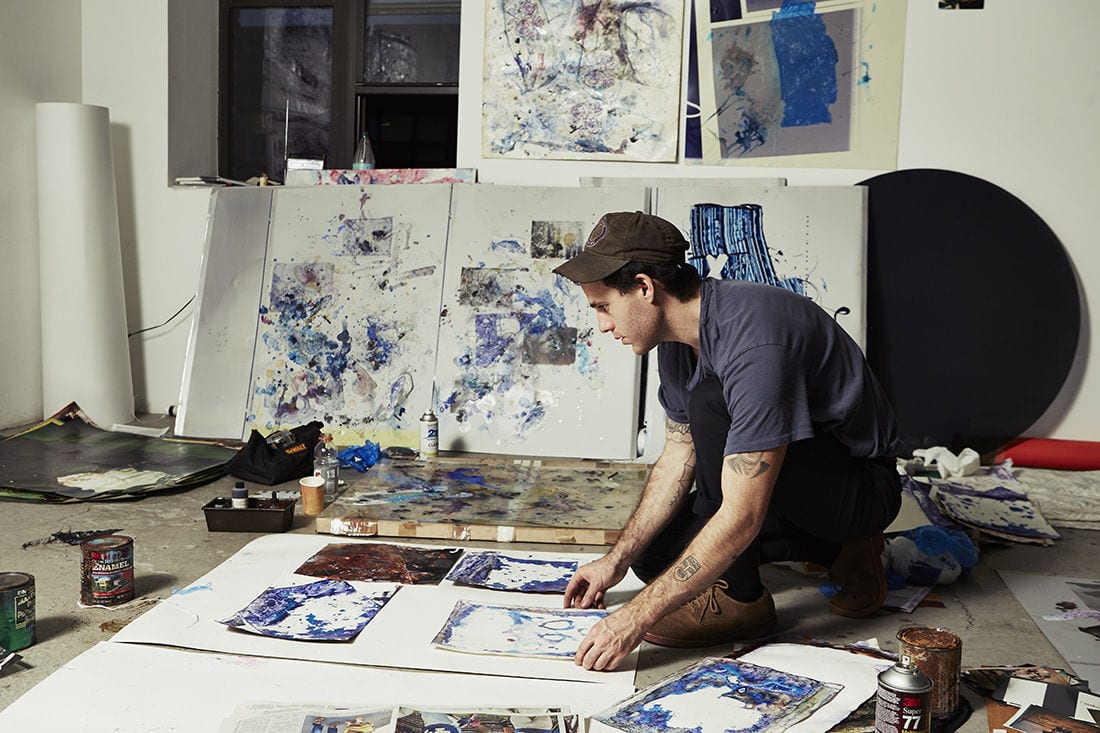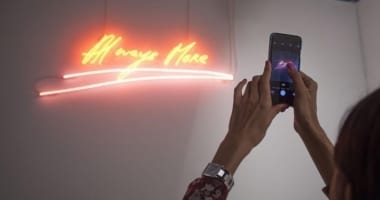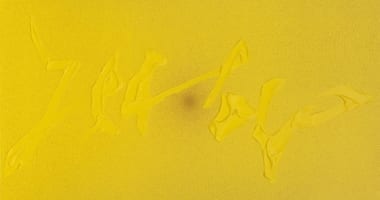Communication is increasingly being reduced to 140 characters, emojis, and voice memos. Despite this, clear prose remains a powerful sales and branding tool within the art world, and beyond.
Artsy has created over 7,000 artist bios, and over the years we’ve learned a few things about what our audience of collectors and art lovers finds valuable when discovering new art. Since Artsy’s partners can now add their own artist bios, we decided to take this opportunity to invite Jessica Backus, Director of Artsy Marketplace, to share some insights into what makes for a compelling bio and how to eloquently summarize an artist’s practice in 120 words.
If you have—or are planning to include—artist biographies on your website, this article was written for you. Read on for our best practices, mistakes to avoid, and a few SEO tips for your gallery’s artist bios.

Detail from Brie Ruais’s studio by Alex John Beck for Artsy
Why Write A Bio?
An artist’s bio is often the first piece of information available to readers and collectors, and as such it offers you a chance to frame their practice and give collectors a reason to want to learn more. Bios also drive search engine optimization (SEO). When returning search results, Google and other search engines privilege written content that is “sticky” (i.e. readers spend time on the page and continue browsing), so providing an engaging, well-written bio is a great way to increase discoverability for your artists.
These are the three cornerstones—tried, tested, and used today by our writers at Artsy—of the perfect artist bio:
- The bio should summarize the artist’s practice—including medium(s), themes, techniques, and influences.
- The bio should open with a first line that encapsulates, as far as possible, what is most significant about the artist and his or her work, rather than opening with biographical tidbits, such as where the artist went to school, grew up, etc. For example: John Chamberlain is best known for his twisting sculptures made from scrap metal and banged up, discarded automobile parts and other industrial detritus.
- The profile should be between 80 and 140 words. The ideal bio is ~120 words, though a tightly written 80-word bio is preferable to a longer bio that includes repetition and filler sentences.
Why 120 Words?
Audience engagement researchers at museums have found that visitors lose interest in wall labels after 150 words. Our philosophy for artist bios is to leave your reader wanting more by limiting your word count to ~120 words. At most, a reader should take away one or two key points.
If you want to provide a more definitive overview of an artist’s practice, consider other channels, such as a press release or a blog post.
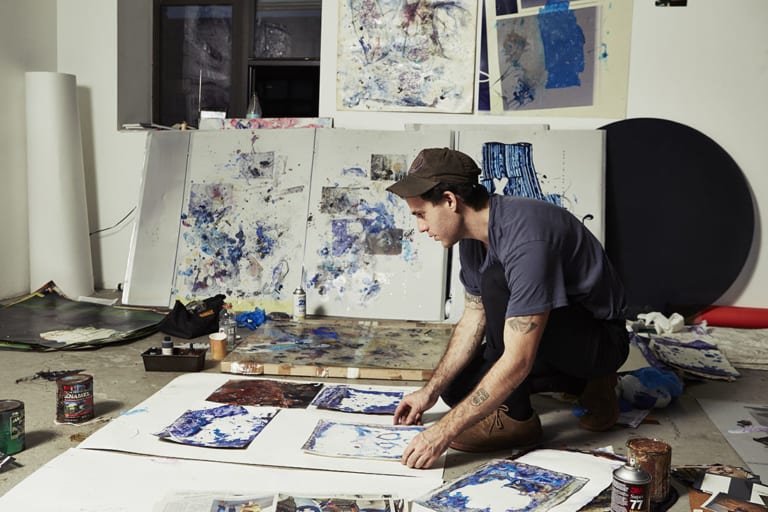
Portrait of Ryan Foerster by Alex John Beck for Artsy
Questions to consider when writing about an artist’s practice
Physical
- What medium/media does the artist work in?
- What is his or her style like?
- What work or works can you talk about that will give a visual description of the above qualities?
Subject matter
- What are common or characteristic themes depicted in the artist’s work?
- What subjects drive the works or provide underlying themes?
Art-Historical
- Why is this artist important?
- What impact has this artist made on history, or what precedent has he or she set in art-making?
- What other artists have impacted the artist’s practice?
- How does this artist redefine a medium or media?
- Who are the artist’s peers or teachers?
Context
- In what political or technological climate is the artist working in? I.e. what historical or political events might have influenced the work?
Popular Culture
- What areas of the arts or popular culture does this artist incorporate into his or her work?
- What other areas of the arts or popular culture does this artist engage with? E.g. creating theatrical sets, costumes, music videos, etc.
Quotes
- Can any of the above questions be answered in a brief (1–2 sentences), engaging quotation from the artist?
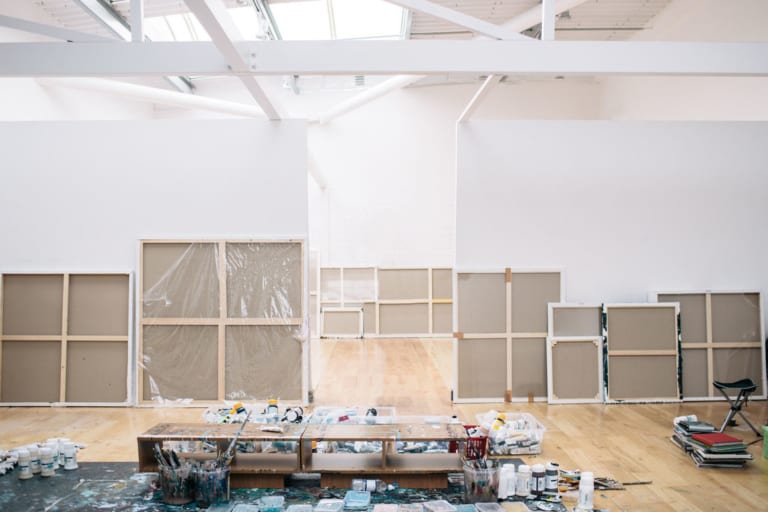
Detail from Genieve Figgis’s County Wicklow studio by Doreen Kilfeather for Artsy.
6 Most Common Mistakes in Artist Bios
Hyperbolic praise
It can be tempting to sing your artists’ praises. We’ve noticed, however, that readers do not respond positively to unsubstantiated claims about an artist’s import (e.g. “Artist X is considered one of the most important artists of the post-war period,” or, “Artist Y is widely regarded for her beautiful work”). Most readers will see right through trumped-up language and, even worse, may become skeptical of the rest of your program. The best way to maximize the power of a good bio is to try to educate, not “hard-sell,” your reader. Numerous studies have shown that the hard sell doesn’t work, especially for younger audiences (read: tech-savvy collectors), who respond most positively to simple and authentic messages.
The “laundry list of accomplishments”
We recommend keeping exhibition highlights and accolades to a minimum (readers who are interested can refer to the artist’s CV). Impressive as these may be, these laundry lists are tedious to read in prose format. They also take up precious real estate, which you could otherwise devote to a real discussion of your artist’s practice.
There are certainly instances where it makes sense to include one particularly outstanding prize or exhibition, for example, an artist’s inclusion in the Venice Biennale. In this case, try to find a way to naturally include mention of the distinction in the normal flow of the text.
Artspeak
Misplaced academic jargon and pseudo-theoretical writing are almost universally despised. Instead of trying to impress other curators, academics, and galleries, focus on your audience of new collectors who may be completely unfamiliar with your artists. Readers want to glean information from your writing, and the best way to do that is to use simple language. A good rule of thumb is to impart one idea per sentence.
Spelling and Punctuation
Nothing undermines the credibility of your content more quickly than spelling and grammar mistakes. When writing, some best practices are:
- Use a serif font (e.g. Times New Roman) to ensure proper formatting of “smart” or curly quotes
- Make sure you have the spell check function turned on, and that your language preferences are set to English
- Have at least one other person, if not two, read over your text
- Don’t forget to put exhibition titles in quotations (e.g. “Greater New York”), and artwork titles in italics (e.g. La Vie, 1903)
Duplicating (or omitting) artist’s nationality, birth year, and death year
It is a common convention in most art writing to include an artist’s nationality, birth year, and death year upon first mention (for example, Alexander Calder [American, 1898–1976]). However, many online databases (including Artsy) store these facts as metadata fields that accompany the artist’s name (see above). Understand how your bio will appear and omit (or include) this information accordingly so as to ensure consistent formatting and keep clutter to a minimum.
Letting bios get stale
For young artists with rapidly evolving careers, be sure to check back every year, or before new exhibitions, to re-assess what the most important aspects of your artist’s practice are.
Our Favorite Artist Bios
Historical Artists
Alexander Calder
American artist Alexander Calder changed the course of modern art by developing an innovative method of sculpting, bending, and twisting wire to create three-dimensional “drawings in space.” Resonating with the Futurists and Constructivists, as well as the language of early nonobjective painting, Calder’s mobiles (a term coined by Marcel Duchamp in 1931 to describe his work) consist of abstract shapes made of industrial materials––often poetic and gracefully formed and at times boldly colored––that hang in an uncanny, perfect balance. His complex assemblage Cirque Calder (1926–31), which allowed for the artist’s manipulation of its various characters presented before an audience, predated Performance Art by some 40 years. Later in his career, Calder devoted himself to making outdoor monumental sculptures in bolted sheet steel that continue to grace public plazas in cities throughout the world.
John Chamberlain
John Chamberlain is best known for his twisting sculptures made from scrap metal and banged up, discarded automobile parts and other industrial detritus. “My work has nothing to do with car wrecks,“ he has said. “I believe common materials are the best materials.” With its emphasis on paint finishes and the raw materials’ lines and seams, his work has been described as a kind of three-dimensional Abstract Expressionist painting. While his breakthrough work dates from the 1960s (namely in sculpture), he has also more recently worked with large-scale photography.
